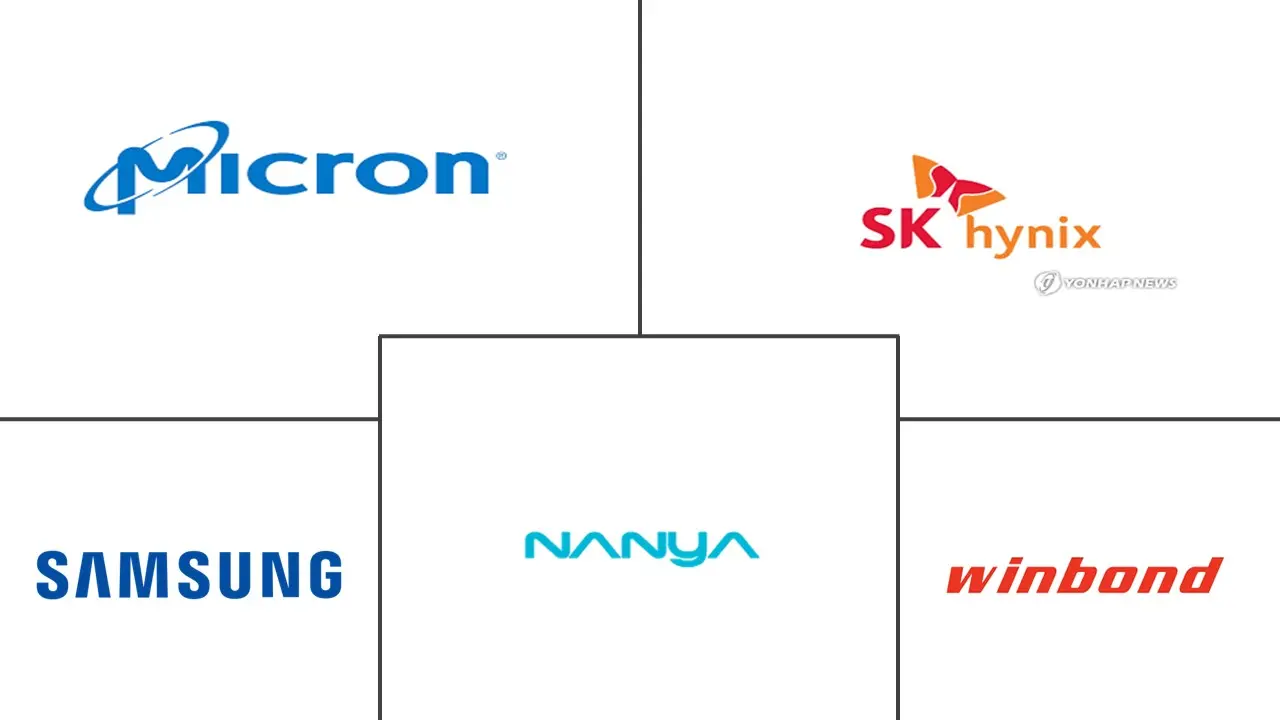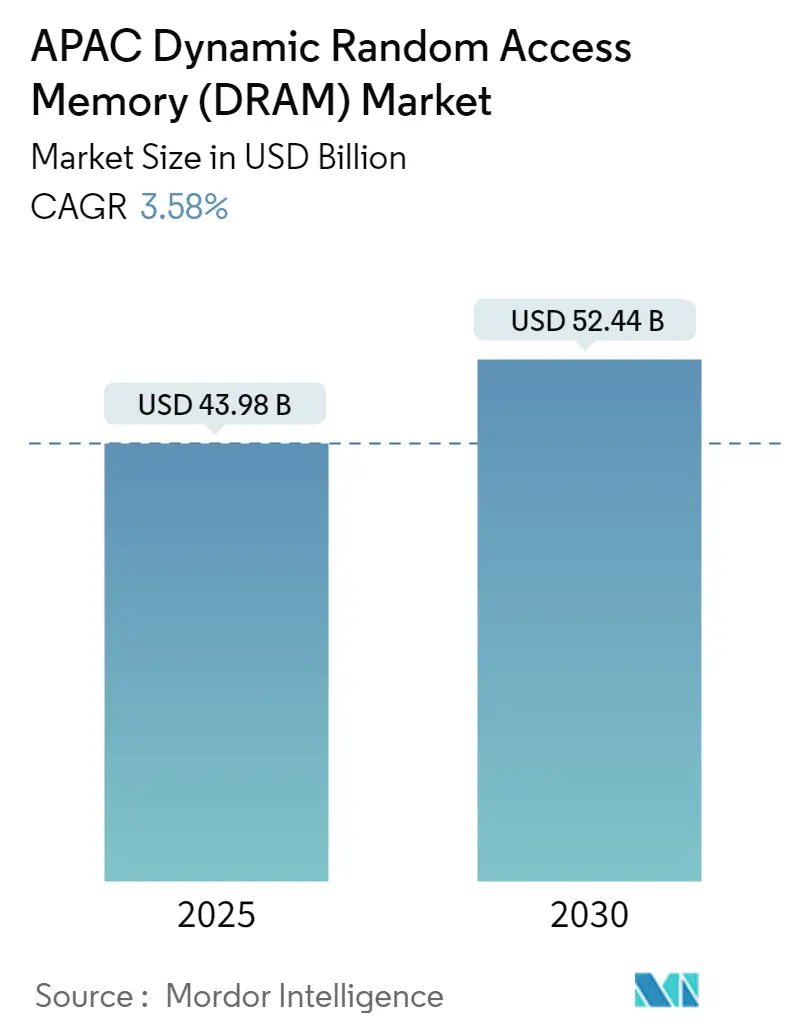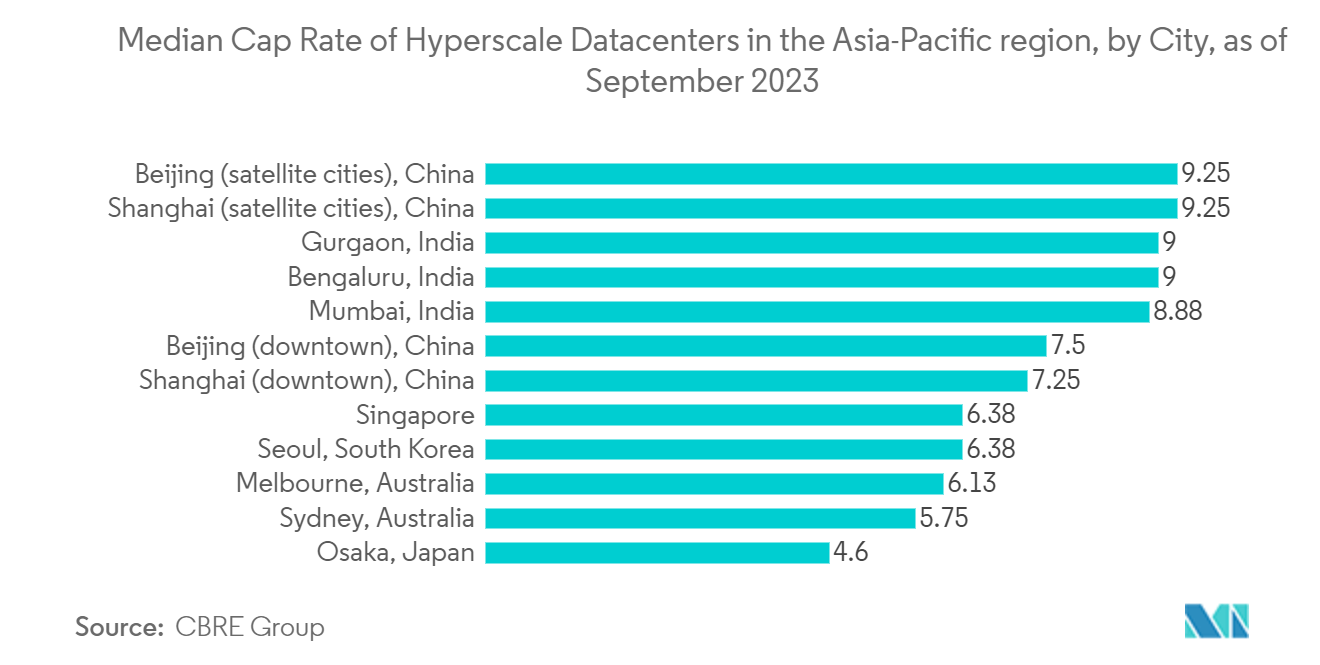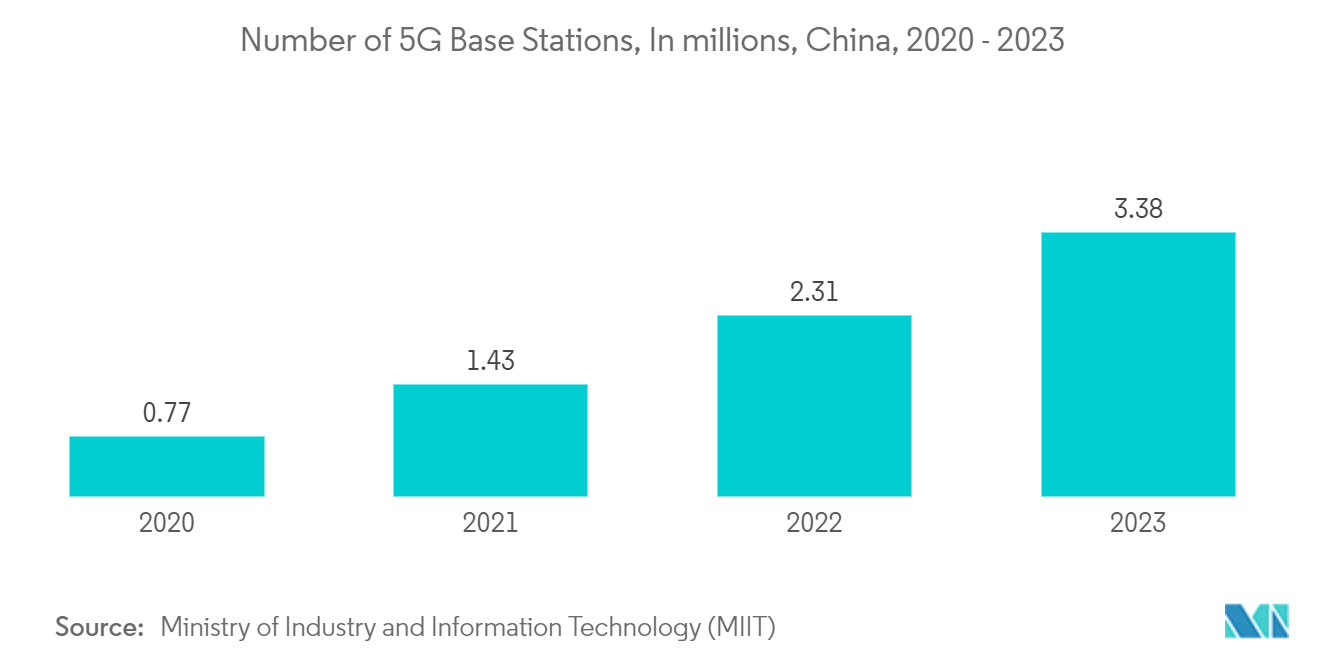APAC Dynamic Random Access Memory (DRAM) Market Analysis
The APAC Dynamic Random Access Memory Market size is estimated at USD 43.98 billion in 2025, and is expected to reach USD 52.44 billion by 2030, at a CAGR of 3.58% during the forecast period (2025-2030).
DRAM is a high-volume commodity memory semi-components generally used in smartphones, tablets, PCs, and servers. Historically, DRAM memory technology has gone through die shrinks. With the release of the advanced memory module, the x/y memory cell pattern on the silicon wafer is turning smaller and smaller.
- Consumer products, like tablets and cameras, industrial equipment and sensors, automotive systems, and medical devices, depend upon DRAM flash memory, incorporated alongside their processors that store data and the code they execute. However, data centers find utilization in DRAM flash memory due to its near real-time reaction to reading/write requests and high data transfer rate. As the need for massive data processing for artificial intelligence and machine learning applications increases, the DRAM storage trend will likely continue to evolve.
- In May 2022, the Overseas Economic Research Institute (OERI) of the Export-Import Bank of Korea estimated that the technological gaps between Korea and China in the memory semiconductor sector were five years for DRAMs and two years for NAND flashes. In response to the launch of new CPUs by Intel Corporation and AMD that support DDR5 DRAM solutions for PCs and servers, South Korean suppliers are developing solutions to complement the arrival of the new CPUs.
- In March 2022, ChangXin Memory Technology (CXMT) announced its plan to manufacture DDR5 in the Chinese market. CXMT's ambitions ramped up recently due to significant investment from its parent company, Ruili Integration. The company aims to invest in more R&D and boost production facilities/capacity.
- However, the rising price sensitivity with ever-growing features in tablets and smartphones is also driving fewer sales for such electronic devices, which is expected to lower the need for DRAMs. The long-life cycle of DRAMS delivers one-time investments for memory solutions unless affected by severe damage, thus, slowing down the manufacturing need for DRAMs and adding challenges to the vendors in the market.
APAC Dynamic Random Access Memory (DRAM) Market Trends
Data Centers' Growth to Drive the Market in the Region
- According to Cloudscene, as of January 2022, China had 447 data centers, only behind the United States, Germany, and the United Kingdom in the number of data centers worldwide. The number is anticipated to grow more. The region has many major data center players like Space DC Pte Ltd, AirTrunk Operating Pty Ltd, China Telecom Corporation Ltd, CtrlS Datacenters Ltd, Advantage Computers Limited, and others, which may further drive the studied market.
- The increase in investment and interest in data center technology can be observed in the innovation of the High Bandwidth Memory 3 (HBM3) DRAM chip, designed by Korea's SK hynix. The company creates and manufactures chips and sensors used in data centers, and the HBM3 boasts the fastest processing speed and biggest capacity in the world. These improved statistics spell a 78% increase in data processing speed over its predecessor, the HBM2E.
- The ROI in the region for data centers is lucrative for investors, thus fueling the demand for data centers and complimenting the growth of DRAM in the region. For instance, according to the CBRE Group, the median cap rate for hyperscale and operational colocation data centers in Beijing and Shanghai was 9.25.
- In the third quarter of 2022, Tokyo was the biggest data center market in the Asia-Pacific region, with a live power supply capacity of around 997 megawatts, 194.3 megawatts for under construction, and 935.3 megawatts in phased IT power. Hence, the significantly growing market for data centers across the region may propel the studied market over the coming years.
China to Hold Significant Market Share
- China is investing billions of dollars into building its semiconductor sector, producing memory and logic chips, the two biggest categories of high-tech chips. In addition, with governmental support, the regional vendors have been increasing their production capacities to meet the increasing global demand for DRAM.
- For instance, in March 2022, ChangXin Memory Technology (CXMT) announced its plan to manufacture DDR5 in the Chinese market. CXMT's ambitions ramped up recently due to significant investment from its parent company, Ruili Integration. The company aims to invest in more R&D and boost production facilities/capacity.
- After successful trials of DDR5 production, CXMT will be setting up its mass production units by the end of this year. The company plans to launch more advanced 17 nm (LP) DDR5 and other advanced process memory chips in China. Such increased domestic production activities may challenge the existing market shares of Samsung Electronics and SK hynix, to name a few.
- The reduction or slowdown in the production of DRAMs in the market could lead to supply chain disruptions. A significant shortage can cause price spikes. The COVID-19 lockdowns in China negatively affected manufacturing, supply chains, and consumer demand for DRAM.
- However, to balance out the production in the region, a local China-based memory company, ChangXin Memory Technologies (CXMT), aims to start delivering samples of DRAM chips built using its in-house developed 17 nm process technology.
- According to the Ministry of Industry and Information Technology (MIIT), China aimed to install 2 million 5G base stations in 2022 to expand the country's next-generation mobile network. Mainland China currently has 1.425 million installed 5G base stations that support more than 500 million 5G users nationwide, making it the biggest network in the world, as per MIIT. The growing implementation of 5G in the country may increase the uptake of 5G-enabled smartphones, creating a positive outlook for the market.
APAC Dynamic Random Access Memory (DRAM) Industry Overview
The Asia-Pacific DRAM market is highly consolidated due to the dominance of a few major prominent players in the region that contribute a maximum market share. Some of the key vendors in the regional market include Samsung Electronics Co. Ltd, SK hynix Inc., Micron Technology Inc., Nanya Technology Corporation, and Winbond Electronics Corporation.
- February 2023 - SK hynix announced that the company has developed Low Power Double Data Rate 5 Turbo (LPDDR5T) mobile DRAM, which operates at a data rate of 9.6 gigabits per second, 13% faster than the previous generation, namely LPDDR5X, which was announced in November 2022. SK hynix indicated that the "T" at the end of the product name directs to "turbo," as it desires to emphasize the fast data processing speed of the memory chip. The company plans to mass-produce the LPDDR5T in the year's second half.
- December 2022 - Samsung Electronics Co. Ltd announced the expansion of its 16-gigabit (GB) DDR5 DRAM, utilizing the industry's first 12-nanometer (nm)-class process technology and the fulfillment of product evaluation for compatibility with AMD. In addition, the company reported that the 12nm-range DRAM would be a key enabler in driving market-wide adoption of DDR5 DRAM. With exceptional performance and power efficiency, the company expects DRAM to be the foundation for more sustainable operations in next-generation computing, data centers, and AI-driven systems.
APAC Dynamic Random Access Memory (DRAM) Market Leaders
-
Samsung Electronics Co. Ltd
-
SK Hynix Inc.
-
Micron Technology Inc.
-
Nanya Technology Corporation
-
Winbond Electronics Corporation
- *Disclaimer: Major Players sorted in no particular order
APAC Dynamic Random Access Memory (DRAM) Market News
- April 2024: Samsung, a consumer tech brand, launched low-power double data rate 5X (LPDDR5X) DRAM chip. Tailored for artificial intelligence (AI) applications, this memory innovation marks a notable leap forward in the tech landscape. LPDDR5X products were leveraged with 12 nanometer-class process technology which helps in achieving the smallest chip size among existing LPDDR chips.
- November 2023: CXMT, a Chinese brand, launched its DRAM innovation: LPDDR5. This milestonesignifies a breakthrough in the Chinese market and also extends CXMT's footprint in the mobile terminal sector. The LPDDR5, the latest iteration of low-power double data rate synchronous dynamic random access memory, showcases a remarkable advancement. It touts a 50% boost in both single-die density and speed over its predecessor, LPDDR4X, hitting 12Gb and 6400Mbps, respectively.
APAC Dynamic Random Access Memory (DRAM) Industry Segmentation
Dynamic random access memory, called DRAMS, is a type of memory used in various computing and electronic devices like PCs, smartphones, music players, laptops, netbooks, and tablet computers.
The Asia-Pacific Dynamic Random Access Memory (DRAM) market is segmented by architecture(DDR3, DDR4, DDR5, and DDR2/Others), application (smartphones/tablets, PCs/laptops, data centers, graphics, consumer products, and automotive), and country (China, Japan, Korea, Taiwan, and Rest of Asia Pacific). The market sizes and forecasts are provided in terms of value (USD) and volume (units) for all the above segments.
| By Architecture (Value and Volume) | DDR3 |
| DDR4 | |
| DDR5 | |
| DDR2/Others | |
| By Application (Value and Volume) | Smartphones/Tablets |
| PCs/Laptops | |
| Data Centers | |
| Automotive | |
| Graphics | |
| Consumer Products | |
| Other Applications | |
| By Country (Value and Volume) | China |
| Korea | |
| Taiwan | |
| Japan |
APAC Dynamic Random Access Memory (DRAM) Market Research Faqs
How big is the APAC Dynamic Random Access Memory (DRAM) Market?
The APAC Dynamic Random Access Memory (DRAM) Market size is expected to reach USD 43.98 billion in 2025 and grow at a CAGR of 3.58% to reach USD 52.44 billion by 2030.
What is the current APAC Dynamic Random Access Memory (DRAM) Market size?
In 2025, the APAC Dynamic Random Access Memory (DRAM) Market size is expected to reach USD 43.98 billion.
Who are the key players in APAC Dynamic Random Access Memory (DRAM) Market?
Samsung Electronics Co. Ltd, SK Hynix Inc., Micron Technology Inc., Nanya Technology Corporation and Winbond Electronics Corporation are the major companies operating in the APAC Dynamic Random Access Memory (DRAM) Market.
What years does this APAC Dynamic Random Access Memory (DRAM) Market cover, and what was the market size in 2024?
In 2024, the APAC Dynamic Random Access Memory (DRAM) Market size was estimated at USD 42.41 billion. The report covers the APAC Dynamic Random Access Memory (DRAM) Market historical market size for years: 2019, 2020, 2021, 2022, 2023 and 2024. The report also forecasts the APAC Dynamic Random Access Memory (DRAM) Market size for years: 2025, 2026, 2027, 2028, 2029 and 2030.
Our Best Selling Reports
Asia-Pacific Dynamic Random Access Memory (DRAM) Industry Report
Statistics for the 2025 APAC Dynamic Random Access Memory (DRAM) market share, size and revenue growth rate, created by Mordor Intelligence™ Industry Reports. APAC Dynamic Random Access Memory (DRAM) analysis includes a market forecast outlook for 2025 to 2030 and historical overview. Get a sample of this industry analysis as a free report PDF download.





_Market.webp)

